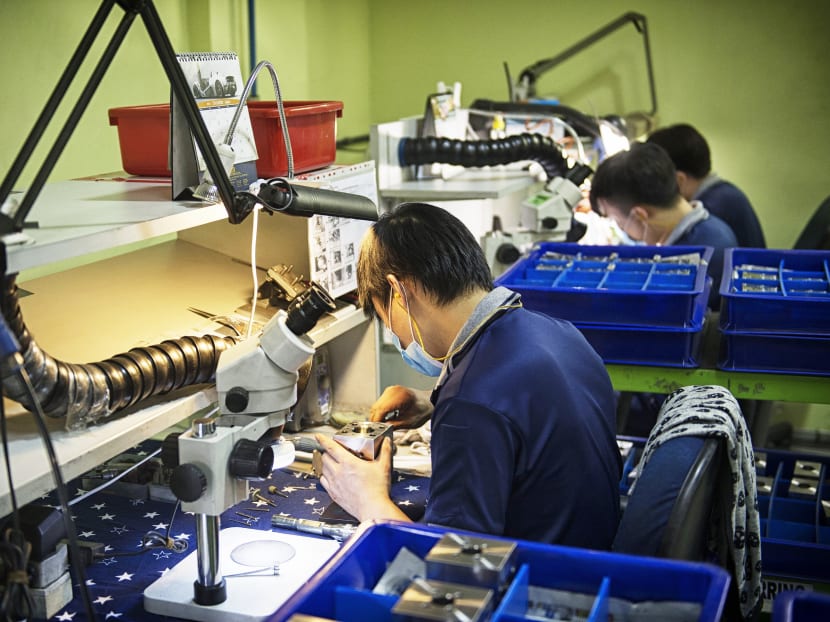Factory activity shrinks for seventh straight month
SINGAPORE — The Republic’s manufacturing sector contracted for the seventh straight month in January although the start of the year is traditionally busier ahead of the Chinese New Year holidays. The sector is expected to continue to battle headwinds for the rest of the year due mainly to a slowdown in the Republic’s top export destination — China.
SINGAPORE — The Republic’s manufacturing sector contracted for the seventh straight month in January although the start of the year is traditionally busier ahead of the Chinese New Year holidays. The sector is expected to continue to battle headwinds for the rest of the year due mainly to a slowdown in the Republic’s top export destination — China.
“Factory activity is likely to contract for one to two more months with a slight uptick in March due to lead indicators reflecting a bounce in commodity and metal prices, beyond that the outlook is murky. The baseline is that we expect a downshift in the second half of this year, driven by a slowdown in China,” said Credit Suisse economist Michael Wan.
DBS added in a note that “chance is high than this festive season will be a relatively quiet one. The cold spell that hit many parts of Asia will likely dampen consumer spending as well as industrial activity”.
January’s Purchasing Managers’ Index (PMI) weakened 0.5 point from the previous month to 49 points, staying below the 50-point mark that separates expansion from contraction. The contraction was due to a decline in new orders, a drop in factory output, and lower employment, the Singapore Institute of Purchasing and Materials Management (SIPMM) said today (Feb 2).
New export orders have been contracting from a year ago resulting in rising stocks of finished goods from April, SIPMM said. Inventory, however, expanded for the second consecutive month, due to a faster rate of supplier deliveries. The electronics sub-index contracted for the seventh consecutive month, down from 0.4 points a month earlier to 48.5 points.
“With the decline in new orders, the export, production, employment and inventory build-ups will be affected leading to dim prospects in the manufacturing sector in the near future,” Dr Tan Khay Boon, senior lecturer at SIM Global Education said.
The manufacturing slowdown was confirmed by Economic Development Board managing director Yeoh Keat Chuan at its annual review. “If you look at the manufacturing sectors for Asian economies: Taiwan, Korea, Malaysia, China, they’ve all been following the same trend. It is true that Singapore’s output numbers are most negative, but I think this is part and parcel of being a small economy, we feel the impact much more,” he said.
Last month, regional PMIs, such as Indonesia and Malaysia registered contractions in factory activity.
Meanwhile, the Republic’s manufacturing competitor South Korea reverted to contraction after expanding for the first time in ten months and Taiwan expanded for the second straight month.
PMIs for China, the Republic’s top export country, remained in contractionary territory. The Caixin/Markit China Manufacturing PMI contracted for the eleventh straight month to 48.4 while the official PMI that covers larger state-owned manufacturers shrank for the sixth consecutive month at 49.4 points.
It is unlikely that Singapore manufacturing sector can get a strong boost from external demand, said Dr Tan. “The poor figures showed that even seasonal stronger demand is unable to lift the manufacturing sector upwards and only a structural improvement can help this sector.”
Even as the share of the manufacturing sector in gross domestic product (GDP) has fallen, the value of the sector has continued to increase.
“If we look at the last 10 years from 2005 to 2014, we were at about 28 per cent (in 2005), now we’re about 18.4 per cent. Manufacturing value added has continued to trend upwards over the last 10 years, the share has dropped because other sectors have grown faster. (Also) when you look at output, it’s been flattish and in fact dropping in 2015 preliminary numbers, (but) the value add per output dollar has continued to increase and this signals our shift towards higher value added activities,” Mr Yeoh explained. Additional reporting by Lee Yen Nee







